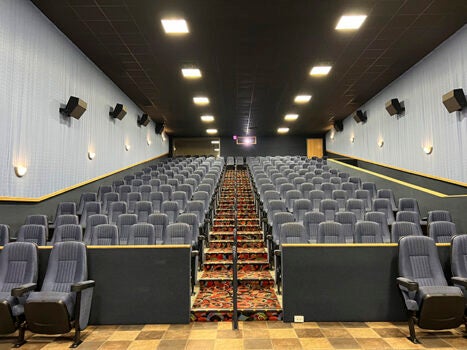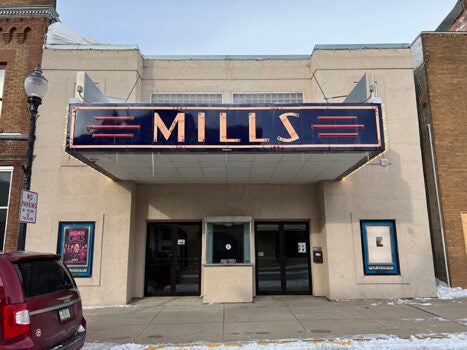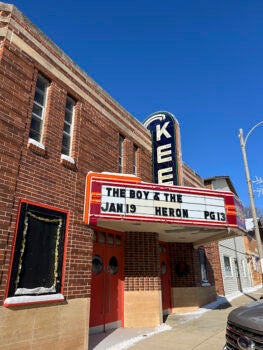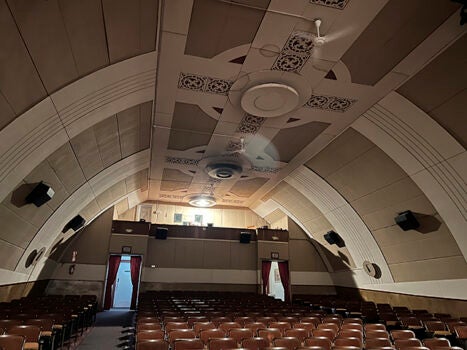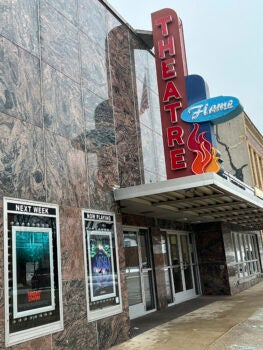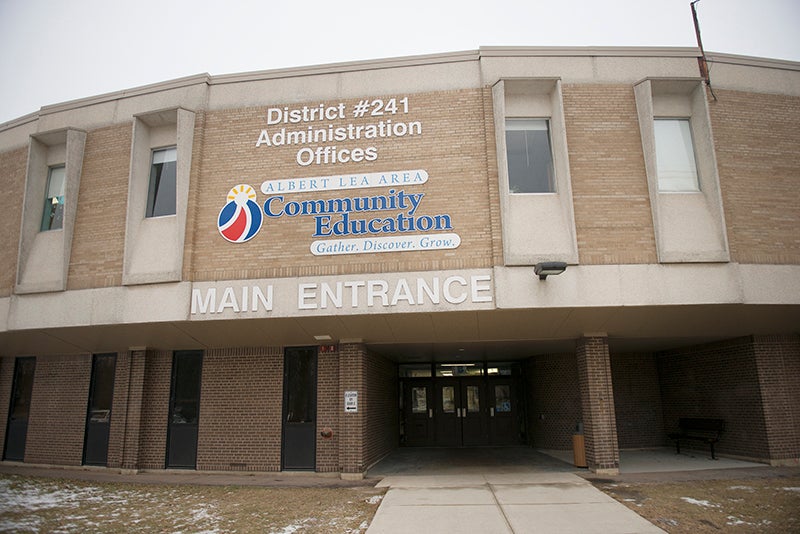Small theaters face challenges, but nothing can replace the actual theater experience
Published 4:00 pm Monday, February 26, 2024
|
Getting your Trinity Audio player ready...
|
By Kim Gooden for the Tribune
Munching on buttery theater popcorn, sipping on refreshing fountain pop, enjoying tasty concessions and watching a movie on the big screen with Dolby surround sound make the movie theater experience special.
Unfortunately, small theaters in the area are facing the challenge of getting people to come in to the theater to watch movies rather than watching them at home on their big screen TVs.
“During COVID people got used to doing things at home and not going out,” said Teresa Nicholson, a board member for the Mills Theater in Lake Mills.
As a result, streaming services such as Disney+, Prime Video and Hulu, to name a few, saw an opportunity to show the movies that people were unable to see at the theater during that time, and film studios began pushing their movies toward streaming services.
Even after theaters were able to reopen during the pandemic, studios continued pushing their movies to the streaming services.
“This changed things significantly because it made it really hard for theaters to get movies that people wanted to see which would bring them back into the theater,” Nicholson said.
While there is still a component of movies being pushed to streaming services, there has been a shift from pushing everything to them, to now pushing films to them that they believe won’t do as well in theaters, according to Nicholson.
This makes new releases available to small theaters, but that presents other challenges.
“We have only one screen,” said Tiffany Schrader, city administrator in Wells, of the city-owned Flame Theater. “As a small theater, we don’t like to play the same movie several weekends in a row, but we often have to do that if we want a new release.”
The reason for this is because sometimes production companies require a two- or three-week showing for certain movies.
“This is hard for a small theater because the first week will do well since people are excited to see the movie,” Nicholson said. “But the second week generally doesn’t have the numbers, and by the third week attendance is pretty low because people have already seen it.”
Dena Trytten, a board member for the Kee Theater in Kiester, agreed, and added that having the same booking agent, who is pushing the blockbusters, means that they are showing the same movies at the same time as the Flame Theater, which is only 14 miles away, and this also has an effect on attendance.
Choosing movies that appeal to their target audience can also be challenging.
“We try to pick movies that appeal to our anticipated audience,” Trytten said. “But it’s hit and miss. It often feels like we’re gambling.”
Schrader agreed, saying, “This year has been a struggle as far as movie titles. We try to focus on being a family theater and sometimes it’s hard to find things we know our people will want to see.”
The Mills Theater also focuses on families and youth, trying to accommodate their interests.
“Anytime there’s an opportunity to show Christian films we do that, because there’s been a lot of requests for that type of films and they do well in our theater because people show up for them,” Nicholson said.
“We also show a lot of regionally-made films because we have some film producers and directors here in Iowa, and we make a concerted effort to support them.”
Occasionally the larger theaters with multiple screens get movies two weeks before the small theaters can get them. This can affect the attendance at the small theaters if people aren’t willing to wait for it to come to them.
“Luckily we have a lot of very supportive community members who, even though they could go to a different town to see a movie, will wait for it to come to Wells,” Schrader said. “That loyalty from people who would hate to see the theater close definitely helps our numbers.”
And numbers are what is needed to help cover the expenses of showing a movie.
Depending on the studio and the film, it costs between $200 and $500 just to get the movie, regardless of how big the theater is. Sometimes there is also an up-front fee. On top of that, theaters pay a percentage of the gross receipts from ticket sales to the studio, which can range from 35% to 70%.
Besides being affected by what’s showing and how many weeks it’s been there, movie attendance is affected by the weather, and by what else is going on in the community.
September through Thanksgiving are the slowest time for theaters because kids are back in school and studios are not releasing a lot of big films then because they know it’s slow.
Attendance is good from Thanksgiving into the new year because a lot of big films are released then.
For the Kee Theater, the costs associated with electricity and heat during the cold, slow months from mid-January through March, have resulted in the theater being closed during that period.
“Last year we filled the LP tank and found that we spent more on LP than on the movie we brought in,” said Mike Eilertson, a Kee Theater board member.
With no movie rental or heating bills, it saves the theater some money.
In the meantime, they make plans and try to get the best movie they can find for their reopening in the spring.
All three theaters have upgraded digital and surround sound systems to give movie-goers a good experience when they come to the theater.
While all three small theaters face many of the same challenges, there are differences as well.
The Mills and Kee Theaters are both 501(c)(3) nonprofit organizations dependent on community support and donations to offset the expenses when revenues from ticket sales and concessions aren’t enough to break even.
When Lake Mills Entertainment Inc. (LMEI) began the project to rebuild the theater that had fallen into disrepair, a local artist, Floyd Thomas, did a painting specifically for the group to sell as prints to raise money for the project. Many other groups, organizations, foundations and individuals donated time and money to the theater project which was completed in 2008.
Then, in 2012, LMEI applied for grants and worked with the city of Lake Mills to open a second screen.
The theater was self-sustaining until COVID hit, and they were mandated to shut down for three months.
Once they were able to reopen, attendance was not where it needed to be to break even, so LMEI did a GoFund Me fundraiser which raised $16,000 and made a huge difference in being able to weather the low attendance during that time, according to Nicholson.
The years since COVID have gotten steadily better, and after having a very good year in 2023, things are almost back to pre-COVID levels at the Mills Theater.
Before COVID, the Mills Theater was open Monday through Sunday. When they reopened, they decided to focus on weekends, being open Thursday through Sunday.
The Kee Theater, under the direction of The Kee Theater Civic Association, relies on an annual fundraiser, which will be held in the spring, to help keep the theater running.
While they used to be open every weekend, now they are open one or two weekends a month, depending on the movie that is being shown.
With the population of Kiester down to 480 residents, population is a factor in attendance almost as much as big screen TVs and streaming, according to Trytten.
Eilertson believes not having a place where people can go for supper also plays a factor in attendance at the Kee Theater.
Despite the challenges, both Trytten and Eilertson believe there is no better way to watch a movie than on the big screen.
“Going to the theater and sitting among other people enjoying the same experience is a social event,” Eilertson said. “We just need to get more people to want that feeling.”
Trytten is hopeful that “maybe, just maybe, going to the theater will make a comeback like vinyl records have.”
Being city-owned, the Flame Theater is unable to accept donations, so when the theater is not making money, they have reserve funds that make up the difference. They also get assistance through the state and have received a couple of grants that were specifically for theaters, according to Schrader.
“Now that things have gone back to normal, we have rebounded and things are back to where they used to be for the Flame Theater,” she said.
The Flame Theater is available to rent for schools, groups and individuals who want to come in and watch a movie.
“If people rent the theater and bring in a Blu-ray DVD, we will show it on the big screen,” Schrader said.
Both Mills and Kee Theaters are also available to rent for special events or private showings if people bring in a Blu-ray DVD.
The Mills Theater has a conference room and a VIP room for moms with crying babies or birthday party guests who want to watch a movie in the privacy of the 10-seat viewing room.
“We’ve rented the theater and the conference room out for birthday parties, baby showers, a wedding reception, a memorial service, legislative forums, and health fairs,” Nicholson said.
The Kee Theater has been rented out for many of the same types of events, and they will be hosting live music on their stage during Kiester Days at the end of June.
All three theaters are working hard to find creative ways to bring people in to watch movies on the big screen and enjoy the theater experience, and those who are overseeing the theaters are deeply grateful to the communities who support them.
Mills Theater hours
Screen 1: Thursday-Saturday at 7 p.m.; Sunday at 3 p.m. and 7 p.m.
Screen 2: Thursday-Saturday at 7:30 p.m.; Sunday at 3:30 p.m. and 7:30 p.m.
Ticket prices: Adults – $5; students – $3; children 3 and under – Free
Kee Theater hours
Friday and Saturday: 7 p.m.; Sunday at 3 p.m.
Ticket prices: Adults – $5; under 18 and senior citizens – $4
Flame Theater hours
Friday-Monday at 7 p.m.; Sunday matinee at 2 p.m.
Ticket prices: Friday-Sunday, all seats – $5; Monday, all seats – $4


